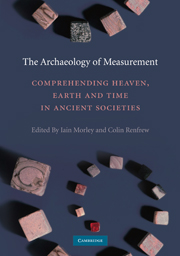Book contents
- Frontmatter
- Contents
- List of figures and tables
- List of contributors
- Acknowledgements
- The Archaeology of Measurement
- Introduction: Measure: Towards the construction of our world
- SECTION I NUMBER: COUNTING, MATHEMATICS AND MEASURE
- SECTION II MATERIALISING THE ECONOMY
- SECTION III DIMENSIONS AND BELIEF
- 10 Architectural measurements in the Indus cities: The case study of Mohenjo-Daro
- 11 Teotihuacan city layout as a cosmogram: Preliminary results of the 2007 Measurement Unit Study
- 12 Aztec dimensions of holiness
- 13 Establishing direction in early Egyptian burials and monumental architecture: Measurement and the spatial link with the ‘other’
- SECTION IV CALENDAR AND COSMOLOGY
- SECTION V THE SPIRITUALITY OF MEASURE
- Index
- References
13 - Establishing direction in early Egyptian burials and monumental architecture: Measurement and the spatial link with the ‘other’
Published online by Cambridge University Press: 05 June 2012
- Frontmatter
- Contents
- List of figures and tables
- List of contributors
- Acknowledgements
- The Archaeology of Measurement
- Introduction: Measure: Towards the construction of our world
- SECTION I NUMBER: COUNTING, MATHEMATICS AND MEASURE
- SECTION II MATERIALISING THE ECONOMY
- SECTION III DIMENSIONS AND BELIEF
- 10 Architectural measurements in the Indus cities: The case study of Mohenjo-Daro
- 11 Teotihuacan city layout as a cosmogram: Preliminary results of the 2007 Measurement Unit Study
- 12 Aztec dimensions of holiness
- 13 Establishing direction in early Egyptian burials and monumental architecture: Measurement and the spatial link with the ‘other’
- SECTION IV CALENDAR AND COSMOLOGY
- SECTION V THE SPIRITUALITY OF MEASURE
- Index
- References
Summary
Orientation in space is an important aspect of measurement most commonly associated with direction finding. Humans tend to divide geographical space in a horizontal plane into four primary directions or areas deriving from an embodied experience of the world: in front, behind, left and right (Tuan 1977, 34–37). As the body is mobile and positions are relative, establishing, remembering or communicating direction requires external reference. In the absence of a compass or equipment for measuring direction, reference can be made to landscape features or, over longer distances and in the absence of distinctive landscape features (for example, at sea), reference can be made to the Sun and stars, or, where they exist, prevailing winds (see also Morley, this volume).
In settled communities, patterning in orientation is sometimes found in architecture. In many regions this derives from environmental considerations: structures oriented towards or away from a prevailing wind or towards or away from the Sun, depending on the conditions of a particular area. Patterning is also frequently found in the orientation of structures toward landscape features such as the sea, a river, or a route or feature created by human intervention in the landscape. Sometimes, however, patterning in orientation may be found in contexts in which pragmatic explanations are lacking or seem unlikely. These may suggest underlying religious or cosmological considerations; examples include patterning in the orientation of tombs, the orientation of mosques toward Mecca or churches toward the east (replacing earlier orientation toward Jerusalem).
Information
- Type
- Chapter
- Information
- The Archaeology of MeasurementComprehending Heaven, Earth and Time in Ancient Societies, pp. 170 - 180Publisher: Cambridge University PressPrint publication year: 2010
References
Accessibility standard: Unknown
Why this information is here
This section outlines the accessibility features of this content - including support for screen readers, full keyboard navigation and high-contrast display options. This may not be relevant for you.Accessibility Information
- 2
- Cited by
